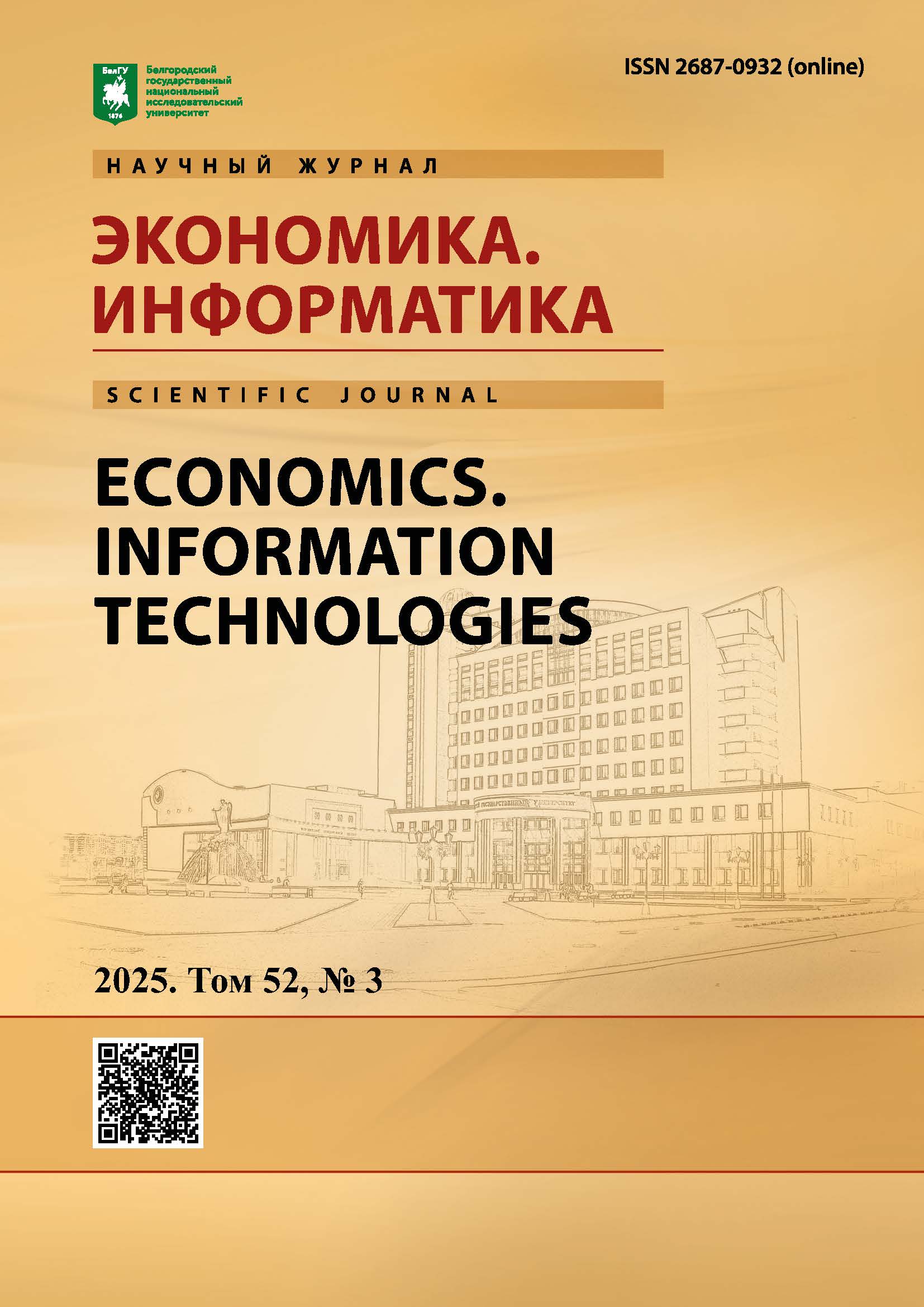Метод прогнозирования продолжительности работ капитального ремонта зданий на основе нечеткого логического вывода
DOI:
https://doi.org/10.52575/2687-0932-2025-52-3-697-709Ключевые слова:
автоматизация планирования капитального ремонта зданий, сетевой график, метод оценки и анализа программ, нечеткие множества, нечеткий логический вывод, нейронная сеть, продолжительность работАннотация
Целью представленного в статье исследования является совершенствование автоматизированных средств планирования капитальных ремонтов зданий на основе разработки метода прогнозирования продолжительности выполняемых работ. Предложенный метод основан на применении нечеткого логического вывода для оценивания коэффициента корректировки продолжительности выполнения работы относительно нормативного значения. Настройка параметров нечеткого вывода осуществляется с помощью нейронной сети, обучение которой производится с применением ретроспективных данных о результатах выполнения аналогичных работ с участием конкретных исполнителей и использованием определенных наименований материалов. Представлены результаты вычислительных экспериментов, которые показали работоспособность предложенного метода и целесообразность его применения на практике.
Скачивания
Библиографические ссылки
Список литературы
Ершов Р.М., Топчий Д.В., 2021. Методика формирования сетевого плана капитального ремонта и реконструкции общественных зданий с использованием теории нечетких множеств. Строительное производство, 3: 41–48.
Махди Т.Н., Игитян Е.В., Польщиков К.А., Корсунов Н.И. 2022. Оценивание эффективности функционирования диалоговой системы на основе применения нечеткого вывода с нейросетевой настройкой. Экономика. Информатика, 49(2): 356–374. DOI 10.52575/2687-0932-2022-49-2-356-374. Польщиков К.А., Лазарев С.А., Константинов И.С., Польщикова О.Н., Свойкина Л.Ф., Игитян Е.В.,
Балакшин М.С. 2020. Модель для оценки эффективности выполнения робототехнической системой коммуникативных функций. СТИН, 6: 4–7.
Польщиков К.А., Польщикова О.Н., Игитян Е.В., Балакшин М.С. 2019. Алгоритм поддержки принятия решений по выбору средств обработки больших массивов естественно-языковых данных. Научные ведомости Белгородского государственного университета. Серия: Экономика. Информатика, 46(3): 553–562. DOI: 10.18413/2411-3808-2019-46-3-553-562.
Топчий Д.В., Ершов Р.М., Токарский А.Я. 2022. Особенности строительно-монтажных работ при капитальном ремонте и реконструкции административных зданий. Строительное производство, 4: 52–58.
Aliahmad M., Miri M., Rashki M. 2024. Comparison of Importance Sampling Method with Other Probability Estimation Methods for Completion of Construction Projects. Journal of Structural and Construction Engineering,11(3): 131–145.
Aliyu A.M. 2024. Project Management: An Objective Assessment of Activity Duration. Open Access Journal of Data Science and Artificial Intelligence, 2(1), 1–9.
Andiyan A., Putra R.M., Rembulan G.D., Tannady H. 2021. Construction Project Evaluation Using CPM- Crashing, CPM-PERT and CCPM for Minimize Project Delays. Journal of Physics: Conference Series, 1933 (1): 012096.
Aulia S., Cipta H. 2023. Network Planning Analysis Using CPM and PERT Methods on Optimization of Time and Cost. Sinkron. Jurnal Dan Penelitian Teknik Informatika, 7(1): 171–177.
Chang Y., Jiang Y., Zhang C., Xue A., Chen B., Zhang W., Xu L., Liu X., Dai Y. 2021. PERT based emergency disposal technique for fracture failure of deepwater drilling riser. Journal of Petroleum Science and Engineering, 201: 108407.
Deng J., Jian W. 2022. Estimating Construction Project Duration and Costs upon Completion Using Monte Carlo Simulations and Improved Earned Value Management. Buildings, 12 (12): 2173.
Desticioğlu B. 2022. Project planning with CPM and PERT methods: example of defence industry. Journal of Naval Sciences and Engineering, 18(2): 363–385.
Farida Y., Anenda L.P. 2022. Network Planning Analysis on Road Construction Projects by CV. X Using Evaluation Review Technique (PERT)-Critical Path Method (CPM) and Crashing Method. International Journal of Integrated Engineering, 14(4): 377–390.
Haekal J., Masood I. 2023. Simulation of ERP project scheduling using CPM and PERT method with promodel: A case studies in food and beverage companies in Jakarta Selatan, Indonesia. AIP Conference Proceedings, 2530 (1): 040003.
Hudda S., Barnwal R., Chejara T., Khurana A. 2025. An MCDA and PERT Based Novel Approach for Prioritization of User Stories in Agile Environment. Computational Science and Computational Intelligence, 2505: 248–262.
Putra E.S., Rodhi N.N., Ratnasari A.K. 2024. Scheduling Analysis on the Heavy Rehabilitation Construction Project of the Dr. R. Koesma Tuban Hospital Building Using the PERT Method. Borneo Engineering: Jurnal Teknik Sipil, 8: 4977.
Polshchykov K.A., Velikanova A.S., Igityan E.V. 2022. Neural network natural language processing tools for identifying personal priorities in the project performer's selection in the field of smart agriculture. IOP Conference Series: Earth and Environmental Science, 1069(1): 012012.
Silva J., Ávila P., Patrício L. 2022. Improvement of planning and time control in the project management of a metalworking industry – case study. Procedia Computer Science, 196: 288–295.
Tam D.S.H., Liu Y., Xu H., Xie S., Lau W.C. 2023. PERT-GNN: Latency Prediction for Microservice-based Cloud-Native Applications via Graph Neural Networks. Proceedings of the 29th ACM SIGKDD Conference on Knowledge Discovery and Data Mining, 2155–2165.
Zaneldin E., Ahmed W. 2024. A Generic Framework for Managing Schedule and Cost Risks of Construction Activities Using PERT and the EV Technique. Buildings, 14(7): 1918.
References
Ershov R.M., Topchiy D.V. 2021. Methodology for Forming a Network Plan for Capital Repair and Reconstruction of Public Buildings Using the Theory of Fuzzy Sets. Construction production, 3: 41–48 (in Russian).
Mahdi T.N., Igityan E.V., Polshchikov K.A., Korsunov N.I. 2022. Evaluation of the Dialogue System Efficiency Based on the Application of Fuzzy Inference with Neural Network Settings. Economics. Information technologies, 49(2): 356–374 (in Russian). DOI: 10.52575/2687-0932-2022-49-2-356-374.
Pol'shhikov K.A., Lazarev S.A., Konstantinov I.S., Pol'shhikova O.N., Svojkina L.F., Igitjan E.V., Balakshin M.S. 2020. Model' dlja ocenki jeffektivnosti vypolnenija robototehnicheskoj sistemoj kommunikativnyh funkcij [A model for assessing the effectiveness of a robotic system in performing communication functions]. STIN, 6: 4–7.
Polshchikov К.А., Polshchikova O.N., Igityan E.V., Balakshin M.S. 2019. The algorithm of decision support in the choice of means of processing large amounts of natural language data. Belgorod State University Scientific Bulletin. Economics. Information technologies, 46 (3): 553–562 (in Russian). DOI: 10.18413/2411-3808-2019-46-3-553-562.
Topchiy D.V., Ershov R.M., Tokarskiy A.Y. 2022. Specifics of Construction and Installation Works during Capital Repairs and Reconstruction of Administrative Buildings. Construction production, 4: 52–58 (in Russian).
Aliahmad M., Miri M., Rashki M. 2024. Comparison of Importance Sampling Method with Other Probability Estimation Methods for Completion of Construction Projects. Journal of Structural and Construction Engineering,11(3): 131–145.
Aliyu A.M. 2024. Project Management: An Objective Assessment of Activity Duration. Open Access Journal of Data Science and Artificial Intelligence, 2(1), 1–9.
Andiyan A., Putra R.M., Rembulan G.D., Tannady H. 2021. Construction Project Evaluation Using CPM- Crashing, CPM-PERT and CCPM for Minimize Project Delays. Journal of Physics: Conference Series, 1933 (1): 012096.
Aulia S., Cipta H. 2023. Network Planning Analysis Using CPM and PERT Methods on Optimization of Time and Cost. Sinkron. Jurnal Dan Penelitian Teknik Informatika, 7(1): 171–177.
Chang Y., Jiang Y., Zhang C., Xue A., Chen B., Zhang W., Xu L., Liu X., Dai Y. 2021. PERT based emergency disposal technique for fracture failure of deepwater drilling riser. Journal of Petroleum Science and Engineering, 201: 108407.
Deng J., Jian W. 2022. Estimating Construction Project Duration and Costs upon Completion Using Monte Carlo Simulations and Improved Earned Value Management. Buildings, 12 (12): 2173.
Desticioğlu B. 2022. Project planning with CPM and PERT methods: example of defence industry. Journal of Naval Sciences and Engineering, 18(2): 363–385.
Farida Y., Anenda L.P. 2022. Network Planning Analysis on Road Construction Projects by CV. X Using Evaluation Review Technique (PERT)-Critical Path Method (CPM) and Crashing Method. International Journal of Integrated Engineering, 14(4): 377–390.
Haekal J., Masood I. 2023. Simulation of ERP project scheduling using CPM and PERT method with promodel: A case studies in food and beverage companies in Jakarta Selatan, Indonesia. AIP Conference Proceedings, 2530 (1): 040003.
Hudda S., Barnwal R., Chejara T., Khurana A. 2025. An MCDA and PERT Based Novel Approach for Prioritization of User Stories in Agile Environment. Computational Science and Computational Intelligence, 2505: 248–262.
Putra E.S., Rodhi N.N., Ratnasari A.K. 2024. Scheduling Analysis on the Heavy Rehabilitation Construction Project of the Dr. R. Koesma Tuban Hospital Building Using the PERT Method. Borneo Engineering: Jurnal Teknik Sipil, 8: 4977.
Polshchykov K.A., Velikanova A.S., Igityan E.V. 2022. Neural network natural language processing tools for identifying personal priorities in the project performer's selection in the field of smart agriculture. IOP Conference Series: Earth and Environmental Science, 1069(1): 012012.
Silva J., Ávila P., Patrício L. 2022. Improvement of planning and time control in the project management of a metalworking industry – case study. Procedia Computer Science, 196: 288–295.
Tam D.S.H., Liu Y., Xu H., Xie S., Lau W.C. 2023. PERT-GNN: Latency Prediction for Microservice-based Cloud-Native Applications via Graph Neural Networks. Proceedings of the 29th ACM SIGKDD Conference on Knowledge Discovery and Data Mining, 2155–2165.
Zaneldin E., Ahmed W. 2024. A Generic Framework for Managing Schedule and Cost Risks of Construction Activities Using PERT and the EV Technique. Buildings, 14(7): 1918.
Просмотров аннотации: 234
Поделиться
Опубликован
Как цитировать
Выпуск
Раздел
Copyright (c) 2025 Экономика. Информатика

Это произведение доступно по лицензии Creative Commons «Attribution» («Атрибуция») 4.0 Всемирная.


